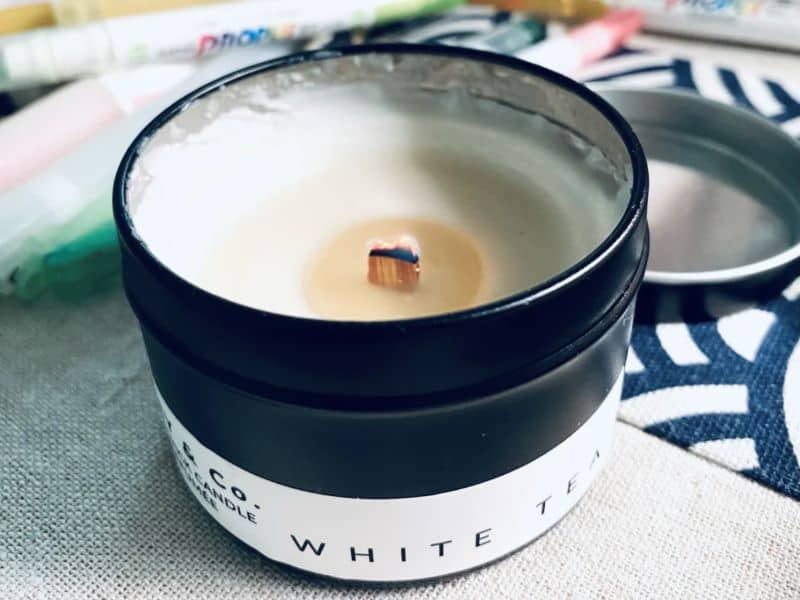Unless you’re burning a candle made with a wooden wick, popping and crackling noises are a sign that something is wrong.
A candle might pop and crackle while burning for a number of reasons. Its wick might be too long or there might be excessive debris on top of the wax, both of which interfere with how the candle burns.
Continue reading to learn more about why candles can make these noises, how to address unsafe candle burning conditions, and how to avoid lighting candles that may burn irregularly.

Is It Normal for a Candle to Pop and Crackle?
When I first light a candle after trimming its wick, I can sometimes hear it crackle a few times.
Honestly, I’m not sure of the cause, but it’s something that only lasts for a few seconds. In all likelihood, there is lint on top of the candle that I didn’t see prior to lighting it. Since the noises don’t persist, it doesn’t become a problem.
But if your candle makes popping and crackling noises for minutes or hours, this is not normal, and it needs to be addressed.
What Causes a Candle to Pop and Crackle?
If your candle is consistently making these noises, it’s best to troubleshoot without hesitation to make sure you’re burning your candle safely.
Here are three main causes for these noises:
- Wick type
- Wick length
- Dusty wax
Let’s explore these causes in more detail.
1. Wick Type: Wooden Wicks
Candles made with wooden wicks are the only ones that should pop and crackle. Companies like WoodWick Candle create multi-sensory candles that remind you of a crackling wood burning fireplace.
Such candles burn safely and some even have a dancing flame, which would also pose caution if the wick weren’t made of wood.
So if you enjoy hearing the crackling sound, then you may want to learn more about WoodWick.
2. Wick Length: Cotton Wicks
But as I mentioned, these noises are only a good thing if you’re burning a candle with a wooden wick.
When burning candles made with cotton or other natural fiber wicks, the popping and crackling noises are unwelcome.
With natural fiber wicks, their length is often the culprit. When a wick is too long, it can generate soot, the flame can grow too high, and the wick can mushroom.
An erratic flame can pop and crackle as it gets out of hand. If this is the case, you should immediately extinguish the flame.
Read more: Wood Wicks vs. Cotton Wicks
3. Dirty Wax Surface
As I shared earlier, from time to time there’s dust or lint on the surface of my candle that can be hard to see. This leads to popping or crackling noises, but only for a short time.
When there’s lots of debris, like broken and charred matches, heavy dust, random small objects or particles on the surface of the candle, this is problematic.
You don’t want to light a candle that’s dusty or has anything on its surface but wax.
Preventing Pops & Crackles When Burning Candles
If a candle burns irregularly, it may cause a fire. Jumping flames can creep up nearby curtains or other flammable items. Popping and crackling might seem like a loud nuisance, but these noises can also pose a fire hazard if not taken care of right away.
Always Monitor Lit Candles
The first step at fire prevention is to never leave a lit candle unattended.
If you light a candle, and then leave the room, you may not hear it popping or crackling. If you don’t hear these noises, then you can’t address the problem or prevent a fine.
Don’t light a candle if you don’t plan to stay nearby.
Proper Storage
One of the best things you can do when your candle isn’t burning is store it properly. Candles are best stored in a cool, dry place. Keep them away from extreme hot or cold temperatures.
Next, it’s ideal to keep them covered. If your candle comes with a lid, use it to protect your candle wax from dust and debris.
If a lid wasn’t included, cut out a piece of cardboard or other material and lay it over the rim of your candle.
Be Mindful of Debris
If you haven’t covered your candles when not in use, all isn’t lost. Before lighting your candle, simply take a lint-free cloth that’s slightly dampened with water and gently wipe the surface of the candle wax.
If your candle is made with soy and/or coconut wax, make sure to wipe as lightly as possible. Both of these waxes are quite soft and can smudge or shift around in the cleaning process.
Whatever you do, NEVER use alcohol to wipe the surface of your candle. It’s highly flammable.
Keeping your candle covered also helps keep its fragrance strong.
Wick Maintenance
In addition to storing your candle properly, you want to care for it by regularly trimming the wick.
After your candle has cooled, nip the wick using sharp scissors or a wick trimmer. As the wax height decreases, having a good wick trimmer on hand simplifies this process.
You’re aiming for a wick that’s no more than ¼ inch (a little over half a centimeter) high. Keeping the wick trimmed prevents sooting and mushrooming when lit in the future, which in turn, prevents crackling and popping.
Avoid Drafts
Flames grow high and become wild if they’re allowed to burn near a draft or ventilation system.
It’s best not to place a lit candle directly beneath your central cooling vent. The same is true if it’s placed near an air conditioning unit or an open window on a windy day.
If you notice that your candle is popping or crackling under these conditions, blow it out, carefully relocate it, and then light the wick again. If the jar is too hot, allow it to cool down before picking it up to move it.
It only takes a slight breeze to move papers or curtain panels as well. So by sitting your candle in a breeze-free zone, you’re also engaging in fire prevention.
Choose a Level Surface
It may seem to go without saying, but it also helps to make sure your candle is on an even table or shelf.
Similar to the last point, you want the flame’s oxygen source to be as steady as possible. If the candle is tilted or in a spot where it might tip over, this can feed the flame, causing it to grow too large. An oversized flame only leads to problems.
Popping and crackling being the most minor issues in comparison to the greater devastation that might occur to your home.
Tools & Tips for Proper Candle Burning
When extinguishing a candle, blowing it out should usually be the last resort. Think about the lovely aroma that fills your space. And then consider what happens when you blow out the candle flame. That lovely fragrance becomes a little stenchy pretty quickly.
Soon the smell of smoke snuffs out any sign that you’d just burned a candle for three hours.
Wick Maintenance Kit
- 3 in 1 Candle Accessory Set: This wick trimmer set includes candle wick trimmer (6.89 * 2.5 * 1.5in), candle snuffer (7.48* 1.01in), candle wick...
- Premium Candle Care Kit - This durable candle trimmer set is made of polished stainless steel material, Candle accessory set is very shiny and not...
- Candle Wick Trimmer - Trim the wicks with ease, to prevent soot and also increase candle burning time. Tips: The machine oil applied to the wick...
- Candle Bell Snuffer - Seal the wick preventing smoking and smoldering. No more worry about accidentally spraying melted wax.
- Candle Wick Dipper - To hook the wick or extinguish flame, prevent wick smoldering. These candle accessories can be used on various occasions, at...
This kit includes a wick trimmer, candle snuffer, and wick dipper. With this kit, you not only avoid the overpowering smell of smoke by using the wick dipper or candle snuffer, you also have a tool for regularly trimming your wick.
You already know the benefits of keeping your wick trimmed. Properly snuffing out the flame also helps prevent carbon buildup, which in turn prevents popping and crackling noises.
Final Thoughts
Have you wiped off debris, trimmed your wick, and placed your candle in a draft-free zone, but it’s still popping and crackling? If all else fails, then there might have been a manufacturer error. If this is a new candle, you may want to return it to the store for a replacement because it might be defective.
Otherwise, if you take care of your candle as outlined in this article, you should no longer experience consistent popping and crackling after lighting a candle. Instead, you can enjoy its quiet ambient flame while reading, working, or meditating.
But if you want to hear the crackling noise and safely experience that when lighting a scented candle, try wooden wick candles instead.

